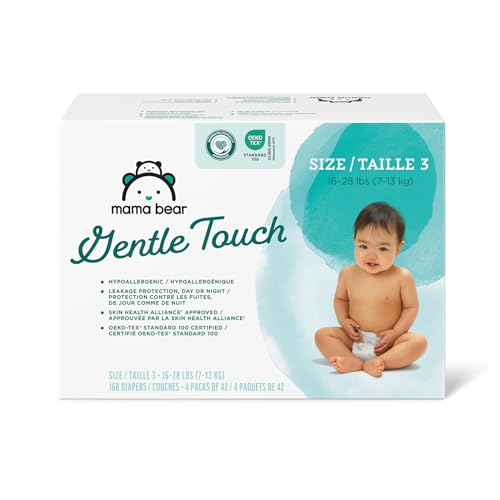
Mama Bear Gentle Touch Diapers - Hypoallergenic, Leakage Protection, 168 Count, Size 3


Polypropylene
Medium RiskPolypropylene is a polymer derived from propylene monomers, widely used in various products due to its versatile properties. It serves as a key component in applications such as packaging, textiles, automotive parts, and consumer goods, offering durability and resistance to chemical exposure.
Sustai Insights
Polypropylene provides structural integrity and is lightweight, making it an effective material for many applications. While it is generally considered low risk for carcinogenicity and reproductive toxicity, there are moderate concerns regarding allergies and immunotoxicity. Environmentally, it poses risks as a pollutant and does not significantly bioaccumulate. Regulatory bodies have imposed some restrictions on its use, reflecting its medium risk level. Safe handling practices are recommended, and biodegradable alternatives are available, emphasizing the need for sustainable choices in product design.
Sodium Polyacrylate
Low RiskSodium polyacrylate is a sodium salt of polyacrylic acid, commonly used as a thickener, absorbent, or gelling agent in various personal care and household products. It is known for its ability to retain moisture and improve product texture.
Sustai Insights
Sodium polyacrylate offers functional benefits such as moisture retention and texture improvement in formulations. It is considered to have low health risks, with negligible concerns regarding carcinogenicity, allergies, or reproductive toxicity. Environmentally, it poses minimal risk as a pollutant and is not bioaccumulative. Regulatory bodies impose few restrictions, indicating its safety profile. Overall, it is regarded as low risk, making it a viable option in formulation practices.
Polypropylene
Medium RiskPolypropylene is a polymer derived from propylene monomers, widely used in various products due to its versatile properties. It serves as a key component in applications such as packaging, textiles, automotive parts, and consumer goods, offering durability and resistance to chemical exposure.
Sustai Insights
Polypropylene provides structural integrity and is lightweight, making it an effective material for many applications. While it is generally considered low risk for carcinogenicity and reproductive toxicity, there are moderate concerns regarding allergies and immunotoxicity. Environmentally, it poses risks as a pollutant and does not significantly bioaccumulate. Regulatory bodies have imposed some restrictions on its use, reflecting its medium risk level. Safe handling practices are recommended, and biodegradable alternatives are available, emphasizing the need for sustainable choices in product design.
Sodium Polyacrylate
Low RiskSodium polyacrylate is a sodium salt of polyacrylic acid, commonly used as a thickener, absorbent, or gelling agent in various personal care and household products. It is known for its ability to retain moisture and improve product texture.
Sustai Insights
Sodium polyacrylate offers functional benefits such as moisture retention and texture improvement in formulations. It is considered to have low health risks, with negligible concerns regarding carcinogenicity, allergies, or reproductive toxicity. Environmentally, it poses minimal risk as a pollutant and is not bioaccumulative. Regulatory bodies impose few restrictions, indicating its safety profile. Overall, it is regarded as low risk, making it a viable option in formulation practices.
Discover the Mama Bear Gentle Touch Diapers, designed for your baby's delicate skin. These hypoallergenic diapers provide ultimate comfort and protection while being mindful of the environment.
- Hypoallergenic Protection: Dermatologist-tested and free from harsh chemicals like chlorine and parabens, ensuring safety for sensitive skin.
- Leakage Security: Enjoy up to 12 hours of reliable protection with a wetness indicator that signals when it's time for a change.
- Comfort-Focused Fit: The thin, flexible design allows for natural movement, keeping your little one comfortable throughout their day.
- Breathable Cover: An innovative outer layer helps maintain a dry and healthy environment for your baby's skin.
- Eco-Conscious Choice: Made with 20% post-consumer recycled materials, these diapers reflect a commitment to sustainability without compromising quality.
Choose Mama Bear for a gentle touch that cares for your baby and the planet.
Subscribe & Save with Sustai
- Best Price Guarantee: Always enjoy the lowest prices on sustainable home essentials.
- No Surprises: We’ll notify you before shipping. No hidden fees, ever.
- You’re in Charge: Change, pause, or cancel your subscription anytime with ease.
- Eco-Friendly Deliveries: Our grouped shipments mean less packaging and lower emissions.
Join us on a sustainable journey. Special offers for a limited time! Prices and promotions may change.
Recommended Products
Discover the Mama Bear Gentle Touch Diapers, designed for your baby's delicate skin. These hypoallergenic diapers provide ultimate comfort and protection while being mindful of the environment.
- Hypoallergenic Protection: Dermatologist-tested and free from harsh chemicals like chlorine and parabens, ensuring safety for sensitive skin.
- Leakage Security: Enjoy up to 12 hours of reliable protection with a wetness indicator that signals when it's time for a change.
- Comfort-Focused Fit: The thin, flexible design allows for natural movement, keeping your little one comfortable throughout their day.
- Breathable Cover: An innovative outer layer helps maintain a dry and healthy environment for your baby's skin.
- Eco-Conscious Choice: Made with 20% post-consumer recycled materials, these diapers reflect a commitment to sustainability without compromising quality.
Choose Mama Bear for a gentle touch that cares for your baby and the planet.

You can have at most 2 Sustainable Steals products in your cart
Customer Reviews
Customers’ View
Customers appreciate the affordability and effectiveness of Mama Bear Gentle Touch Diapers, often comparing them favorably to more expensive brands. Many highlight the softness of the diapers, noting they are gentle on sensitive skin, which is an important consideration for health-conscious parents. Although opinions on leakage and absorbency vary, some users report no issues with leaks, while others mention occasional concerns. Eco-conscious consumers value the diapers' use of 20% post-consumer recycled materials, aligning with their sustainability goals. Overall, customers find these diapers to be a reasonable choice for daily use, balancing comfort and cost without compromising on quality.
AI-generated from the text of customer reviewsThis product has no reviews yet.




